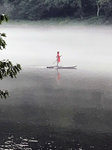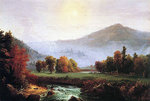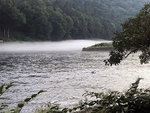 Narrowsburg
NarrowsburgLight Rain Fog/Mist, 43°
Wind: 8.1 mph
 Narrowsburg
NarrowsburgAt the end of a very hot day the temperature was still in the high eighties when I started my walk on River Road north of the post office. A layer of fog had formed and was clinging to the Delaware …
Stay informed about your community and support local independent journalism.
Subscribe to The River Reporter today. click here
This item is available in full to subscribers.
Please log in to continue |



At the end of a very hot day the temperature was still in the high eighties when I started my walk on River Road north of the post office. A layer of fog had formed and was clinging to the Delaware River. Rock islands I often admired from the riverbank could barely be seen this evening. And further upstream—much further—I could see the fog massed thick across much of the river’s width.
It was late summer. Fall had not yet arrived in Callicoon, the small town where the post office was. As I walked along the river, the heat through which I was moving was itself a laden fog-like object. It enveloped me with a heaviness I could almost touch. Pushing against this weight on a day when it hadn’t rained, I thought the cloud of water vapor above the river had formed prematurely and shouldn’t really be there. But there it was—an aberration signifying the waters of a temperate zone river clashing with a warming climate. There was no smashed crockery on the river’s bank, but before my eyes a perilous beauty hung over the river.
Two hundred years ago, Thomas Cole, American patriot, global artist, father of the Hudson River School, immigrated here from England and, amazed by the grandeur and sublimity of the American landscape, applied and adapted ideas he took from John Constable and William Turner and others of a great tradition to stir into life an American artistic adventure. It spanned two generations and a geographical region initially centered in the Hudson Valley but covering also the Catskill, Adirondack, and White mountains and then embracing the Northeast, the American West, and South America. Spotlighted in four shows in 2018—one at the Met in New York City, one at the Albany Institute of History and Art (still ongoing), one at the Thomas Cole Historic Site, Catskill, NY, and one at the British National Gallery at London—Cole had a clear message for our times.
Already during his lifetime, unfettered, pell-mell economic development was creating a culture of hubris. Cole possessed an entrepreneurial spirit and was no Luddite, but he was also a 19th-century Romantic who was sensitive to the destructiveness that accompanied American natural resource exploitation. Through his art, he posed fundamental questions regarding national destiny and environmental preservation. Though many of his disciples turned away from his philosophical legacy, the sensibility the Hudson School promoted eventually helped create the modern environmental movement.
I cannot claim to have a complete knowledge of Cole’s paintings, but the few I’ve seen where fog in landscape is an important feature depict it rising from surfaces to higher altitudes. You see mist drifting up mountain valleys. But this evening, the fog was stagnant over the Delaware. So hot was the air above, it hardly rose. Here and there, however, it wafted over the riverbank, giving me drafts of cooler air imbued with unexpected delight. Had Cole seen the scene before me, I wonder what he would have thought.
An hour into my walk, I came across a scene I can only call apparitional. A young woman, wearing a dress covered by what seemed a filmy shawl, was standing in a canoe drifting across the river’s breadth. I didn’t see her for long. Soon, she was out of sight, fully hidden by the mist.
Such evanescent human presence in landscapes suggesting the numinous was a common feature of classical Chinese art spanning two millennia. In many landscape paintings dominated by immense, lofty mountains you see mist filling magnificent, awe-inspiring river valleys and gorges. You see, too, that mist has a climbing dynamic nature. But this evening, over the Delaware, fog spread sideways, moving ever so stealthily, denting an ancient story.
Comments
No comments on this item Please log in to comment by clicking here